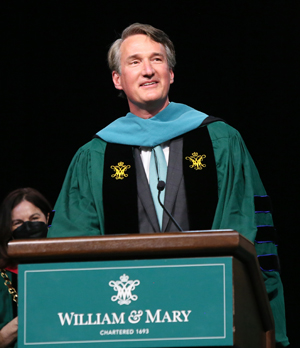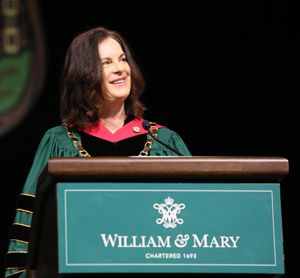Data, water, democracy, careers: Those will be the four areas of focus as William & Mary embarks on a new strategic direction over the next five years, President Katherine A. Rowe stated Friday during the university’s 2022 Charter Day ceremony.
Dubbed Vision 2026, the strategic plan has three aims: to expand W&M’s reach, to educate for impact and to evolve to excel, Rowe said.
“I am incredibly proud of how this community has navigated the past few years,” she said. “The next five years will be different though. We will get to the end of this because we will be choosing transformation that’s different, and we will be using the muscles that we have honed by forced transformation.”

Hosted in Kaplan Arena, Friday’s ceremony was part of a weekend of festivities to celebrate the 329th anniversary of the university’s royal charter. In addition to the ceremony, members of the W&M community were invited to partake in special food offerings within W&M Dining, a winter carnival, a comedy show featuring Matteo Lane and other special events.
The ceremony featured an address from Virginia Gov. Glenn Youngkin, who was inaugurated in January. Youngkin received an honorary degree from the university along with U.S. Rep. Robert “Bobby” Scott and Howard Busbee ’65, J.D. ’67, M.L.T. ’68, an emeritus clinical professor in the Mason School of Business, former president of the W&M Alumni Association and former chair of the W&M Foundation. W&M traditionally invites the commonwealth’s newest governors to speak at the Charter Day ceremony.
New aspects to an old tradition
While this year’s Charter Day ceremony looked in many ways like those of the past, several new facets were added, including a recognition of the university’s Asian Centennial. The cover of the ceremony program was adorned with flowers to represent the centennial, which recognizes the 100th anniversary of the admission of W&M’s first Asian student, Chen Pu-Kao, and the contributions of all students of Asian, Pacific Islander and Middle Eastern descent who followed.

“The flowers remind us to savor moments of success as we strive to make our community more inclusive,” said Rowe. “These centennial events will spark discussions that will turn into actions. They are the buds and blossoms of a stronger community where all may thrive.”
The ceremony also included a reading of W&M’s land acknowledgement that recognizes the Indigenous people who originally inhabited the land where the university now stands. Representatives from two of those nations were in attendance: Chief Keith Anderson of the Nansemond Indian Nation and Chief Lynette Allston of the Nottoway Indian Tribe of Virginia. The acknowledgement was read by Matthew Solomon ’24, a member of the Monacan Indian Nation and president of the American Indian Student Association.
In addition, for the first time students read the university’s charter in four languages, in acknowledgement of the multilingual community that existed at the time of W&M’s founding and the global, and multilingual community that exists on campus today, said Rowe.
Democracy and debate
Throughout the ceremony, speakers highlighted several common themes, such as the importance of teaching and supporting democracy, listening to others with opposing views and learning from and sharing a fuller history as the university plans for the future.
“For 329 years, William & Mary has provided the best and the brightest Virginia has to offer,” Youngkin said. “And I know you are already doing this, but imagine what the next 329 years hold: a college that continues to be renowned as the leader in thought, a hub for innovation, a welcoming environment for spirited debate. But also an institution committed to educating the breadth and diversity of Virginia that sees in every child not just a dream, but the means to empower them to realize it.”

Youngkin praised W&M’s interdisciplinary curriculum for equipping students for a “changing and challenging world,” adding he hopes to see the future with Virginia companies – filled with W&M graduates — leading the world.
Youngkin challenged the university to join the effort to prepare K-12 students for the future by continuing with efforts like its partnership with The Posse Foundation to make higher education more accessible and affordable.
“Education allows children of every background to pursue their dreams to rise above the present circumstances, to become everything they dream of becoming,” Youngkin said. “I want every graduate of a Virginia high school to either be college-ready or career-ready. I want them on pathways to prosperity, with the ability to think critically and perform effectively. I think that’s what the earliest founders of this great college had in mind.”
Before he spoke, the governor’s visit had received a lot of attention on campus. Some members of the W&M community hosted an event in the Sunken Garden as an alternative to the Charter Day ceremony. Others who attended the ceremony held up signs, briefly voiced their disapproval and left the arena when Youngkin received his honorary degree. Others in the crowd wore Youngkin shirts and applauded the governor. The disruption lasted a few minutes and the ceremony continued.
Earlier in the ceremony, Rowe said that listening to others with whom we do not agree is part of being in a democratic society.
“In joining together today, we embody William & Mary’s commitment as a public institution of higher learning to support democracy in action,” she said. “In a pluralistic democracy, part of the process of maturation is to listen to and learn from others who bring differing views. Curiosity is a core institutional value at W&M for that reason. At Charter Day we showcase it fully as an essential part of the educational experience here.”
Chancellor Robert M. Gates ’65, L.H.D. ’98, who helped to bestow the degrees, said he is particularly proud of one objective within W&M’s new strategic plan: to elevate civic engagement and service for the 21st century.
“Core to William & Mary’s ideals and to its future is the open exchange of ideas, tolerance and willingness to listen and to learn, and the determination of all to defend the freedom of expression of diverse opinions – to seek wisdom in mutual respect and, wherever possible, in bridging differences,” he said.

Busbee recalled advice given to him by his parents when they dropped him off at college. His mother’s: “Be nice to everyone.”
“Of course that had some deeper meanings, such as helping others whenever and however you can, and respecting others who may have different opinions,” Busbee said. “But that didn’t mean not to speak up and speak out when it became necessary.”
His father’s advice to leave everything and every place better than he found it contained a similar message.
“The subtext there was that I should encourage teamwork, embracing the diversity of others,” Busbee said. “And where there is conflict, meet somewhere in the middle. As our country’s own founders realized about 95 years after William & Mary received its charter, compromise can be a good thing, as long as you don’t compromise your principles.”
Like Youngkin, Scott said that a college education serves as an equalizer for many in America, and everything possible should be done to make sure it is widely accessible. Scott also recognized W&M’s “very complicated history” as the second-oldest college in the United States, and he encouraged the university to learn from it.
“The college is struggling with that now and on how to present that history,” he said. “Just remember that you will never please everyone, but I urge you to continue that work, acknowledging, as Governor Youngkin said in his inaugural address, both the good and the bad.”
Awards and honors
In addition to the bestowal of honorary degrees, the university celebrated the accomplishments of several members of its community during the event, including this year’s Alumni Medallion recipients. The university also recognized the recipients of this year’s Thomas Jefferson and James Monroe awards, who received their honors during a ceremony on campus Feb. 4.
During the Charter Day dinner hosted by University Advancement on Saturday night, Board of Visitors member Sue H. Gerdelman ’76 received a surprise honor. In recognition of Gerdelman’s work as chair of W&M’s For the Bold comprehensive campaign, along with her dedicated service as chair of the All In athletics campaign and as a former chair of the William & Mary Foundation, D. Bruce Christian ’73 contributed funding to permanently light the exterior of the Wren Building at night.

Rowe announced the project at the dinner by showing a video of the W&M Choir singing in front of the building while it was illuminated with temporary lighting. The permanent lights are expected to be installed by April and are meant to allow people to enjoy one of the most recognizable and historic parts of the university in the evenings. It will be similar to lighting that was added in recent years to Colonial Williamsburg’s Historic Area buildings. Most evenings, the Wren Building will be illuminated with white lights, but it will shine in green and gold for special occasions.
Several significant landmarks around the country were illuminated in green and gold as part of the For the Bold campaign, starting with the Empire State Building in 2016. The campaign concluded in 2020 with $1.04 billion raised.
‘Small steps to magnificent ones’
As Rowe closed the Charter Day ceremony, she said that W&M has been successful throughout the years “because we have understood the moment that we are in, risen to new challenges, and seized the opportunity to lead.”
As the university transitions from a pandemic to endemic state, it will use the lessons learned to advance W&M’s educational mission, focusing on the four cornerstone initiatives of Vision 2026: data, water, democracy and careers.
“By data, I mean that, in the 21st century, it will be the hallmark of an educated person to find patterns in large bodies of data and use those insights in ethical ways,” said Rowe. “William & Mary will lead the evolution of the liberal arts and sciences by integrating computational thinking and data fluency into our research, our curriculum, and our organization, across fields and units.”
By focusing on water, the university recognizes the power of its research to address threats to the world’s water sources and become a leader in global responses to related challenges, Rowe said.
The focus on democracy includes restoring and re-envisioning democratic ideas to tell a more complete story about the United States, especially as it prepares to commemorate its 250th anniversary.

“Our nation is deeply divided,” Rowe said. “A majority of citizens struggle to debate constructively and learn from disagreement. We cannot wrestle together with ideas without a shared understanding of the facts we must wrestle with. The foundation of every great university is our commitment to discovery, to evidence-based argument, and to facts as public goods.”
The focus on careers will ensure that students are grounded in a range of academic disciplines, are fluent in the latest tools and technologies and gain experience in different work environments. The university aims to provide every undergraduate by 2026 with a funded internship or other hands-on learning experience, Rowe said.
While more will be shared about the plan in the coming weeks, a website with additional information has been launched and will serve as the hub for everything related to Vision 2026. But for now, the W&M community should focus on reconnecting with one another, Rowe said.
“At this weary time in pandemic, the most important thing this community can do is to reconnect with each other,” she said. “Prioritize the day-to-day connections that build relationships – study, play, hang out in person. This is W&M’s time to build, from small steps to magnificent ones.”
Erin Jay, Senior Associate Director of University News






